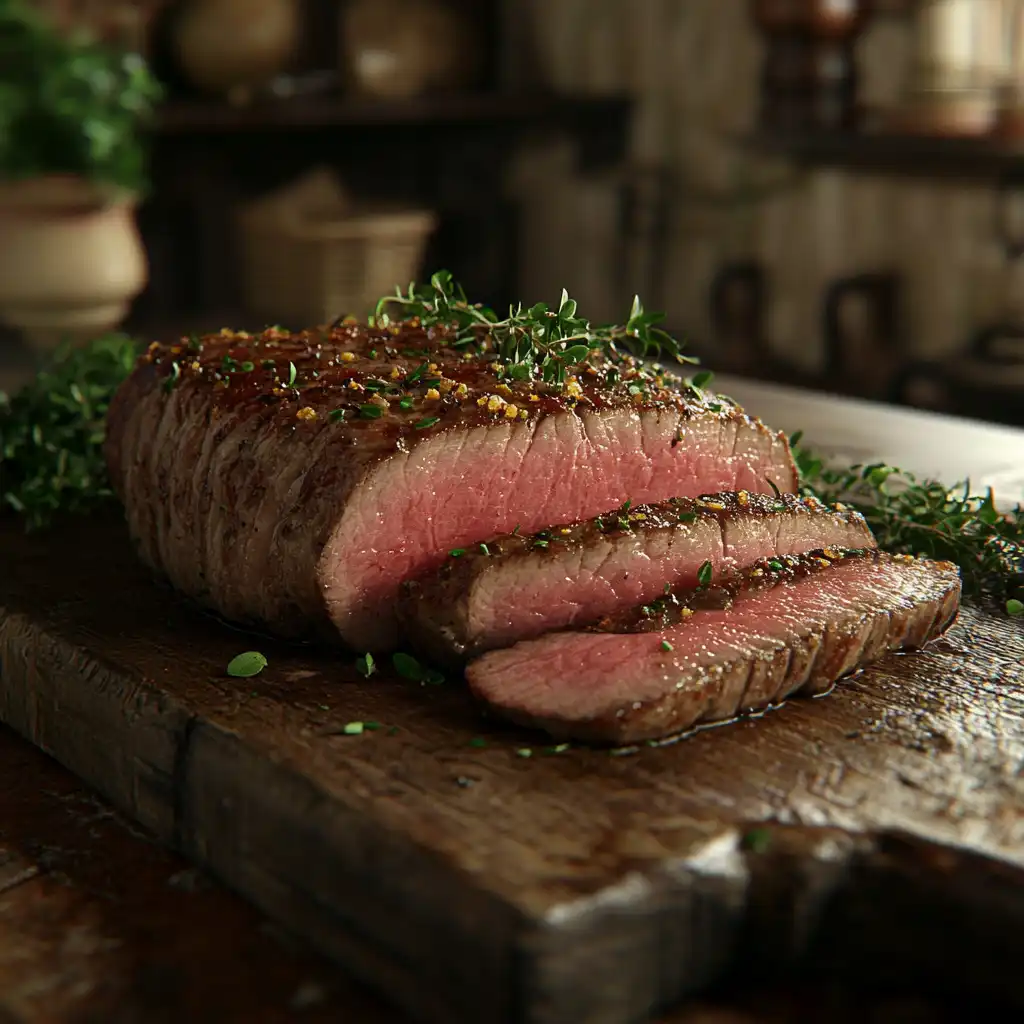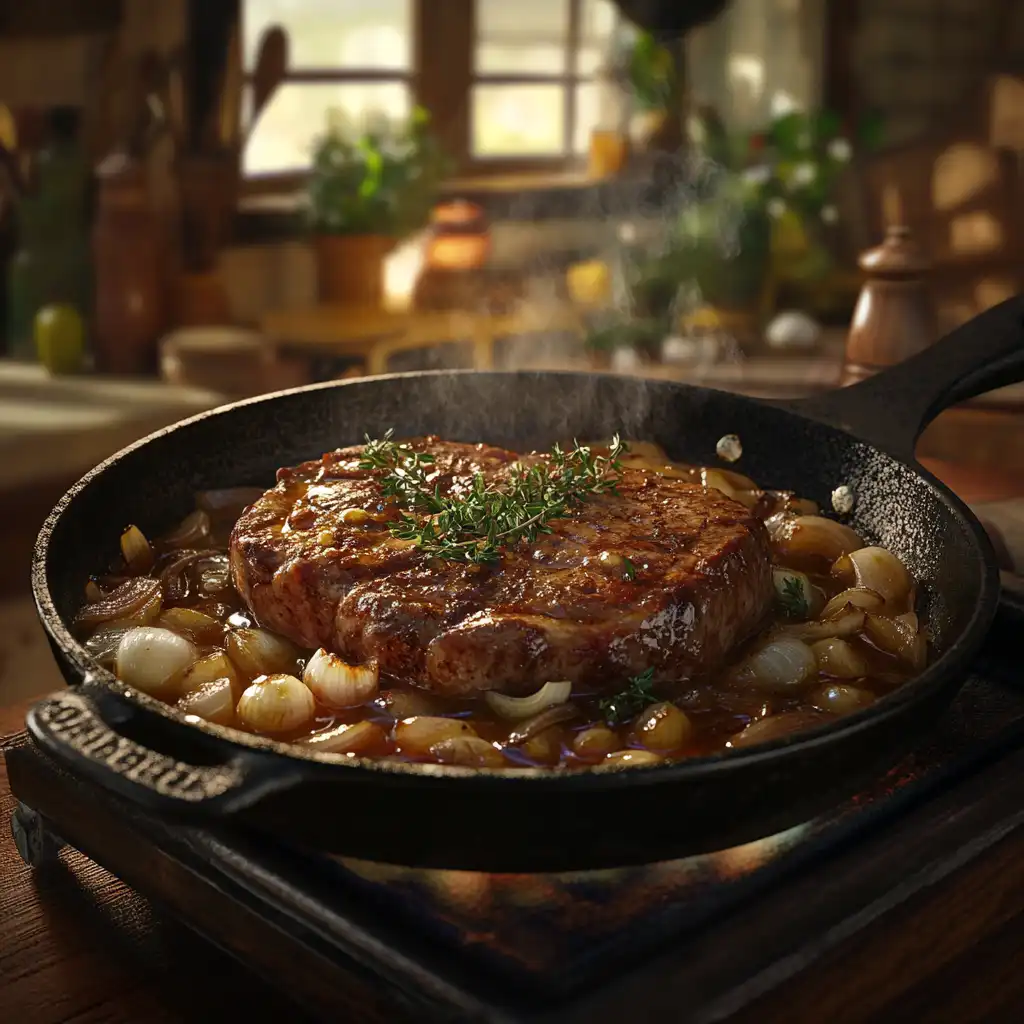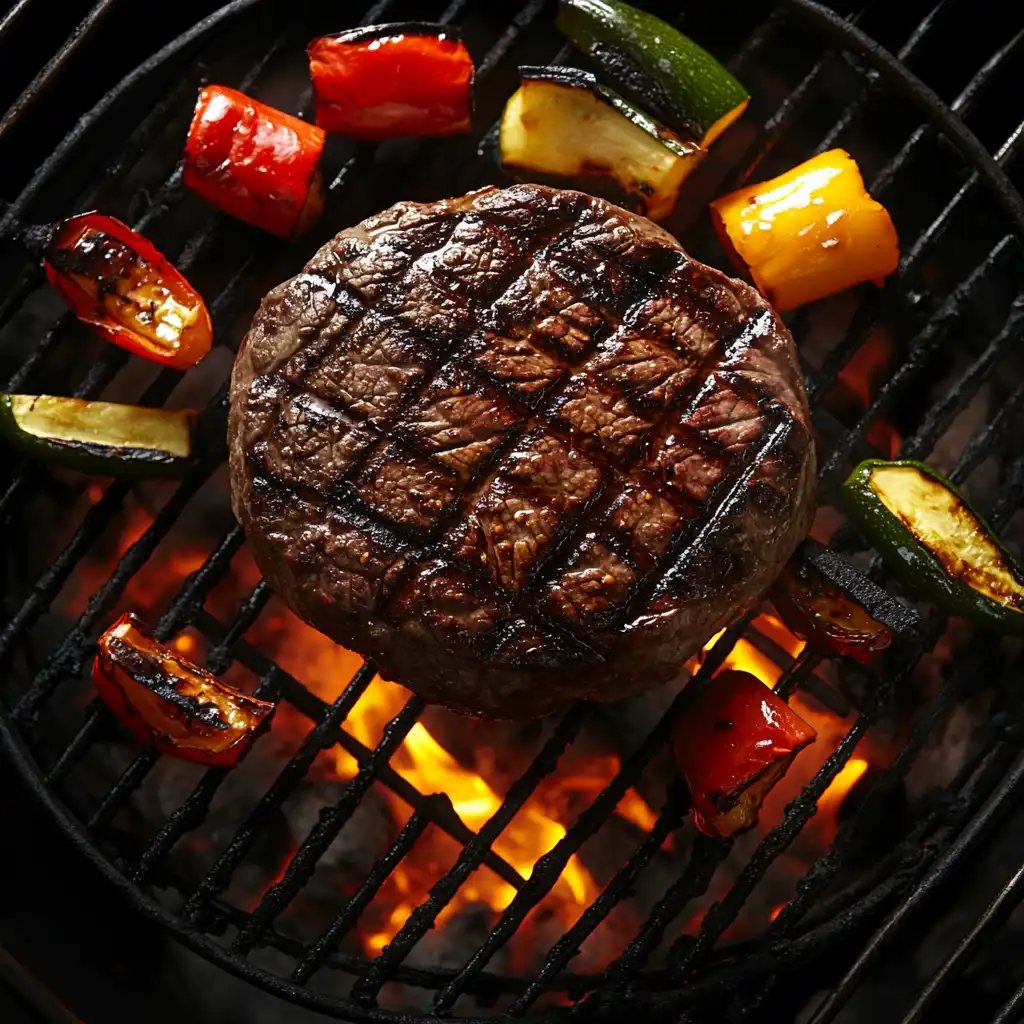
Round steak, a lean and budget-friendly beef cut, may seem tough to cook at first, but with the right techniques, you can master how to cook round steak to perfection. Understanding its characteristics and applying proper cooking methods, such as braising, grilling, or stir-frying, helps unlock its potential for tender and flavorful meals.
Table of Contents
Characteristics of Round Steak
- Lean and Low in Fat: Round steak contains very little fat, making it a healthier option for those watching their fat intake.
- Tough Texture: This cut tends to be less tender because of its location on the cow.
- Affordable: Many people choose round steak for its budget-friendly price.
- Versatile: Cooks can use this cut in many ways, including braising, slow cooking, and grilling after proper tenderizing.
Nutritional Value of Round Steak
Round steak provides several essential nutrients:
- Protein: It offers a high protein content, which helps the body repair muscles and perform other essential functions.
- Iron: The steak supplies iron, which supports oxygen transport in the blood.
- Vitamins: It includes B vitamins like B12 and B6, which aid energy production and brain health.
- Low in Fat: Its low fat content makes it a leaner choice compared to other cuts of beef.
When you prepare round steak correctly, it can become a delicious and nutritious addition to your diet. Learning how to handle and cook this cut effectively will help you bring out its full potential.
Preparing Round Steak Before Cooking
Choosing the Right Cut
Selecting the best cut of round steak is crucial for achieving a delicious dish. Look for cuts that are fresh and have a uniform, bright red color. Avoid steaks with grayish or brown patches, as they indicate oxidation or spoilage. Common types of round steak include:
- Top Round: The most tender part of the round and ideal for roasting or grilling.
- Bottom Round: Slightly tougher but excellent for braising or slow cooking.
- Eye of Round: A very lean cut that works well when roasted or sliced thin for sandwiches.
Understanding the specific characteristics of these cuts helps you match them with the right cooking method.
How to Tenderize Round Steak
Round steak benefits greatly from tenderizing because of its lean and tough nature. Here are some effective methods:
- Mechanical Tenderizing: Use a meat mallet or tenderizer tool to break down the muscle fibers. This method softens the meat and allows marinades to penetrate more deeply.
- Salt Tenderizing: Sprinkle kosher or sea salt over the steak and let it sit for 30–60 minutes. Rinse off the excess salt before cooking. The salt breaks down proteins and improves the steak’s texture.
- Blade Tenderizer: A blade tenderizer pierces the steak with small blades, creating channels that make the meat easier to chew and cook evenly.
Marinating Techniques for Flavor Enhancement
Marinating not only enhances the flavor of round steak but also helps in tenderizing it. Follow these steps for the best results:
- Choose the Right Ingredients: Combine an acidic component (like vinegar, lemon juice, or wine), oil, and seasonings such as garlic, herbs, and spices. The acid helps break down tough fibers, while the oil keeps the steak moist.
- Marination Time: Allow the steak to marinate for at least 2 hours, but no more than 24 hours to prevent it from becoming mushy.
- Even Coating: Place the steak and marinade in a resealable plastic bag or shallow dish. Ensure the marinade coats the meat evenly for consistent flavor.
- Refrigerate: Always marinate round steak in the refrigerator to keep it safe from bacterial growth.
With proper preparation, round steak can transform into a flavorful and tender dish that exceeds expectations.
Cooking Techniques for Round Steak
Pan-Searing: Quick and Flavorful
Pan-searing is a quick and effective way to cook round steak while delivering rich flavor. Not only does this method create a crispy, golden-brown crust, but it also keeps the inside tender and juicy. However, achieving the best results requires careful preparation and execution.
Preparing the Steak for Pan-Searing
- Bring to Room Temperature:
First, take the steak out of the refrigerator about 30 minutes before cooking. This step is essential because it allows the steak to cook more evenly. - Dry the Steak:
Next, pat the steak dry with paper towels to remove any surface moisture. Removing moisture helps create a better sear and prevents steaming. - Season Generously:
After drying the steak, season it generously with salt, pepper, and any preferred spices. This step not only enhances the flavor but also creates a savory crust during searing.
Heating the Pan
- Choose the Right Pan:
To begin, select a heavy-bottomed skillet, such as a cast-iron pan, which heats evenly and retains heat well. - Preheat Properly:
Then, heat the pan over medium-high heat until it is hot but not smoking. Afterward, add a small amount of oil with a high smoke point, such as canola or avocado oil, to prevent the steak from sticking.
Searing the Steak
- Sear One Side:
Carefully place the steak in the hot pan and press down lightly to ensure full contact with the surface. Allow it to cook undisturbed for 3–5 minutes so that a golden-brown crust forms. - Flip and Cook:
Next, flip the steak and cook the other side for 3–5 minutes. If the steak is thicker, you can lower the heat slightly and cook for an additional few minutes to ensure even doneness.
Resting and Serving
- Let It Rest:
Once the steak is done, remove it from the pan and allow it to rest for 5–10 minutes. Resting helps the juices redistribute, making the steak juicier and more flavorful. If you’re preparing a sauce, consider pairing the steak with a flavorful option from this ultimate guide to beef gravy recipes for a perfect finish. - Optional Sauce:
Finally, use the pan drippings to make a quick sauce. For example, you can deglaze the pan with beef stock, wine, or balsamic vinegar and whisk in a pat of butter for added richness.
By following these steps, you can transform a tough round steak into a delightful and satisfying meal. Moreover, pan-searing offers a quick cooking method while ensuring bold flavors and a satisfying texture.
Braising: Low and Slow
Why Braising Works Best
Braising is one of the most effective methods for those learning how to cook round steak because it tenderizes the tough meat while infusing it with rich flavors. This slow cooking process combines both moist and dry heat, breaking down the connective tissues over time. To better understand when braising works best, read our guide on what beef round steak is good for.

Here’s why braising is ideal for round steak:
- Moisture Retention: Cooking the steak in a flavorful liquid, such as broth or wine, prevents it from drying out.
- Tenderization: The low, consistent heat slowly breaks down the tough fibers in the meat, making it tender and easy to cut.
- Flavor Infusion: The liquid used in braising not only keeps the steak moist but also enhances its flavor as it cooks.
To braise round steak:
- Begin by searing the steak in a hot pan to develop a flavorful crust.
- Next, add aromatics like onions, garlic, and herbs, followed by your liquid of choice.
- Cover the pan tightly with a lid and cook on low heat, either on the stovetop or in the oven, for 2–3 hours.
- Once done, let the steak rest before serving to allow the flavors to settle.
Grilling Round Steak: Tips for Success
Managing Heat and Cooking Time
If you’re exploring how to cook round steak with bold, smoky flavors, grilling is an excellent method, but it requires careful attention to prevent the meat from becoming too tough. Proper heat management and timing are essential for success.

- Marinate Before Grilling: Since round steak is lean, marinating it beforehand adds moisture and tenderness. Use a marinade with acidic ingredients like lemon juice, vinegar, or yogurt for the best results.
- Preheat the Grill: Ensure your grill is hot before adding the steak. Use a two-zone setup—one side with high heat for searing and the other with medium heat for finishing.
- Cook Quickly: Sear the steak over high heat for 3–5 minutes per side to develop a charred crust. Then, move it to the cooler zone to finish cooking without drying out.
- Monitor Internal Temperature: Use a meat thermometer to check the doneness. For medium-rare, aim for an internal temperature of 130–135°F (54–57°C).
- Rest Before Serving: Once off the grill, let the steak rest for 5–10 minutes. This step locks in the juices and enhances the flavor.
By using these tips, you can achieve a perfectly grilled round steak with the right balance of tenderness and flavor. Both braising and grilling offer distinct but equally delicious ways to prepare this versatile cut of meat.
Using Round Steak in Recipes
Round steak is a versatile ingredient that works well in a variety of dishes, ranging from quick stir-fries to hearty stews. With the proper preparation, it can adapt to different cuisines and cooking styles, making it a valuable addition to any recipe.
Stir-Fries: Quick and Easy
For those wanting a quick meal while learning how to cook round steak, stir-frying is an excellent choice because its lean and firm texture pairs well with high-heat cooking. When sliced thinly against the grain, the steak cooks quickly and absorbs the flavors of marinades and sauces. For more ideas, explore these beef round steak recipes to elevate your stir-fry dishes.
How to Use Round Steak in Stir-Fries:
- Prepare the Steak: Slice the steak into thin strips, ensuring you cut against the grain for maximum tenderness.
- Marinate for Flavor: Use a marinade with soy sauce, ginger, garlic, and sesame oil to tenderize the meat and enhance its flavor.
- Cook Over High Heat: Heat a wok or skillet over high heat and cook the steak strips quickly, usually 2–3 minutes per side, until they are browned.
- Combine with Vegetables: Add cooked vegetables like bell peppers, broccoli, or snap peas to the skillet and toss with a stir-fry sauce before serving over rice or noodles.
Slow-Cooked Stews and Soups
The toughness of round steak makes it ideal for slow-cooked recipes like stews and soups, where extended cooking times allow the meat to become tender and flavorful.
How to Incorporate Round Steak into Stews and Soups:
- Brown the Steak: Cut the steak into chunks and sear them in a hot pan to develop a rich flavor base.
- Add Aromatics: Include onions, garlic, and spices to create depth in the dish.
- Simmer Slowly: Combine the steak with broth, tomatoes, or wine and let it simmer for 2–3 hours. The slow cooking breaks down the meat’s fibers, resulting in a melt-in-your-mouth texture.
- Enhance with Vegetables: Add hearty vegetables like potatoes, carrots, and celery during the last hour of cooking for a complete meal.
Steak Sandwiches and Wraps
Round steak is also a fantastic option for creating flavorful sandwiches and wraps. Its lean texture and ability to absorb seasoning make it a great protein base for handheld meals.
Steps for Making Steak Sandwiches and Wraps:
- Cook the Steak: Grill, sear, or braise the steak, depending on your preference. For sandwiches, aim for medium doneness for a juicy bite.
- Slice Thinly: Once cooked, slice the steak thinly against the grain to ensure it is easy to chew.
- Assemble Your Meal: Layer the steak on a toasted bun or wrap with toppings like sautéed onions, peppers, cheese, or fresh greens.
- Add a Sauce: Use condiments such as garlic aioli, mustard, or a tangy BBQ sauce to enhance the flavors.
With these approaches, you can use round steak to create delicious and satisfying meals that suit any occasion. From quick stir-fries to hearty soups and wraps, round steak proves its versatility in the kitchen.
Avoiding Common Mistakes
Cooking round steak can be a rewarding experience, but certain mistakes can compromise the texture and flavor of this lean cut. By being mindful of these pitfalls, you can ensure a delicious and tender result.
Overcooking and Drying Out
One of the most common mistakes with round steak is overcooking, which can lead to a tough and dry texture. Since round steak has little fat, it cooks quickly and requires careful attention to timing.
How to Avoid Overcooking:
- Use a Meat Thermometer: Check the internal temperature regularly. For medium-rare, aim for 130–135°F (54–57°C), and for medium, aim for 140–145°F (60–63°C).
- Cook Over Medium Heat: Avoid excessively high heat for extended periods, as it can dry out the steak.
- Rest the Steak: After cooking, let the steak rest for 5–10 minutes. This allows the juices to redistribute, preventing dryness when sliced.
Skipping the Tenderizing Process
Another common mistake is skipping the tenderizing process. Round steak is naturally tough due to its low fat content and heavy muscle use. Without tenderizing, the meat may be chewy and less enjoyable.
How to Properly Tenderize Round Steak:
- Use a Meat Mallet: Pound the steak lightly with a meat mallet to break down its fibers.
- Marinate Before Cooking: Choose a marinade with acidic components like lemon juice, vinegar, or yogurt to soften the meat.
- Salt the Steak: Sprinkle salt over the surface of the steak and let it sit for 30–60 minutes before cooking. This step enhances both flavor and texture.
Using Inadequate Cooking Tools
The tools you use can significantly impact the outcome of your round steak. Using improper equipment often leads to uneven cooking or difficulty achieving the desired texture.
Tips for Choosing the Right Cooking Tools:
- Select a Heavy-Bottomed Pan: Use a cast-iron skillet or stainless-steel pan for even heat distribution during pan-searing.
- Invest in a Meat Thermometer: A reliable meat thermometer ensures you achieve the perfect doneness without guessing.
- Choose the Right Utensils: Use tongs instead of forks to flip the steak. Piercing the meat with a fork can cause valuable juices to escape.
By avoiding these common mistakes, you can elevate your cooking skills and enjoy a perfectly prepared round steak. Paying attention to cooking times, tenderizing techniques, and proper tools ensures a flavorful and tender result every time.
FAQs About Round Steak Cooking
What is the Best Way to Cook Round Steak for Beginners?
For beginners wondering how to cook round steak, braising is one of the best methods to try. It is a forgiving technique that ensures the meat becomes tender and flavorful. Simply sear the steak, add aromatics and liquid, and let it simmer on low heat for a couple of hours. This method requires minimal monitoring and yields consistent results.
Can Round Steak Be Cooked Medium-Rare?
Yes, round steak can be cooked medium-rare, but it requires careful attention. Due to its lean texture, overcooking can result in toughness. Use a meat thermometer and cook the steak until the internal temperature reaches 130–135°F (54–57°C) for medium-rare. Ensure you rest the steak for at least 5 minutes after cooking to allow the juices to redistribute.
How Long Should Round Steak Be Braised?
The ideal braising time for round steak is 2–3 hours on low heat. This allows the connective tissues to break down, resulting in a tender texture. If you are using a slow cooker, set it to low for 6–8 hours. Keep in mind that adding vegetables in the last hour of cooking will prevent them from becoming mushy.
Should I Trim the Fat from Round Steak Before Cooking?
Round steak is naturally lean, but you may find a small amount of fat around the edges. Trimming excess fat is optional and depends on the recipe. For example, if you’re grilling, leaving some fat can enhance flavor. However, for braising or stir-frying, trimming the fat beforehand ensures a cleaner presentation and avoids greasy results.
Can Round Steak Be Used in International Cuisines?
Absolutely! Round steak is versatile and can adapt to various international dishes. For example:
- Asian Cuisine: Use thinly sliced round steak in stir-fries or Mongolian beef.
- Mexican Cuisine: Marinate it with spices and lime juice for fajitas or tacos.
- European Cuisine: Braise it with wine, garlic, and herbs for a classic beef bourguignon.
- Caribbean Cuisine: Slow-cook it with coconut milk and spices for a flavorful stew.
How Do I Store Leftover Round Steak?
To store leftover round steak:
- Cool the Steak: Allow the steak to cool to room temperature before storing it.
- Use Airtight Containers: Place the steak in an airtight container or wrap it tightly with aluminum foil or plastic wrap.
- Refrigerate or Freeze: Store in the refrigerator for up to 3–4 days or in the freezer for up to 3 months. Label the container with the storage date for convenience.
- Reheat Properly: When reheating, use low heat to avoid drying out the meat. Adding a splash of broth or sauce can help retain moisture.
These FAQs address common questions and provide actionable tips for cooking, storing, and enjoying round steak. Whether you’re a beginner or an experienced cook, these insights will enhance your round steak dishes.
Conclusion: Perfecting Your Round Steak
With the right techniques, anyone can learn how to cook round steak, transforming this challenging cut into a versatile and delicious addition to their culinary repertoire. For globally inspired variations, consider using round steak in dishes like the ones featured in the ultimate guide to shaved beef recipes to explore new flavors.. By understanding its characteristics and choosing appropriate cooking methods, you can unlock its full potential.

Start by tenderizing the meat and selecting the right preparation method, such as braising for tenderness, pan-searing for speed, or grilling for bold flavors. Experiment with recipes, whether quick stir-fries, hearty stews, or globally inspired dishes, to suit your taste and creativity.
Avoid common pitfalls like overcooking or skipping essential tenderizing steps, and always use the right tools to achieve the best results. With practice and patience, round steak can transform into a satisfying meal that fits a variety of occasions and cuisines.
Whether you’re a beginner or an experienced cook, mastering round steak allows you to enjoy an affordable, healthy, and flavorful option for your table. So, go ahead—embrace the challenge, try new recipes, and perfect your round steak cooking skills!
